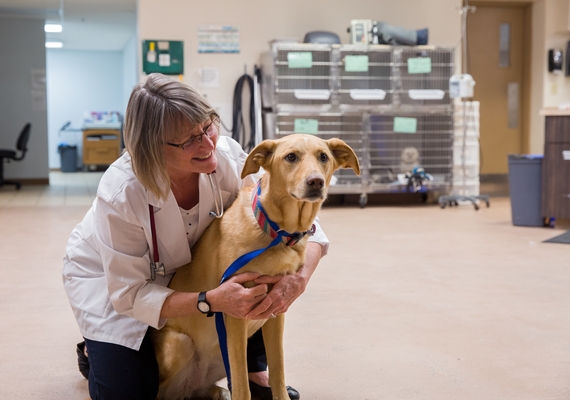
A Small Animal Surgeon

Small Animal Surgery
Dr. Terri Schiller is a small animal surgeon at Western Veterinary Speciality and Emergency Centre and a Senior Instructor in Small Animal Surgery at UCVM. She has particular expertise in canine total hip replacement and has been actively involved in both North American and European veterinary total hip training courses.
Introduction
Watch the video below to meet Dr. Schiller!
Hip Replacement - Preparation
Surgical preparation or preoperation refers to the time before a surgery when the veterinary team is preparing the patient for anesthesia and surgery. This can include a physical exam, blood tests, and presurgical imaging such as radiographs or X-rays, and placing an IV catheter. Additionally, we clip the fur in the area where we are performing the surgery, called the surgical field, and clean the area.
Hip Replacement - Postoperation
Postoperative refers to the time after a surgery when the veterinary team is waking the patient from anaesthesia. This involves monitoring vital signs, normalizing body function, controlling pain, and postsurgical imaging such as radiographs.
Hip Replacement Radiographs
Hover over the images below to learn more!
Preoperation Radiographs
In a normal pelvis, the hip joint looks like a socket and the femur has a nice round ball at the end of it. This socket and ball fit together, with the socket “hugging” the femur to make the joint stable.
In Nika's X-rays you can see that she has a very shallow socket- it almost looks flattened. This is because her femur has been rubbing around the rim of her socket, wearing it down and making it a flat surface. The ball of her femur has also undergone some changes – instead of being a nice, round ball it has become squished and flattened out.
These changes are a result of Nika's hip joints being too loose as a puppy causing too much movement in the joints resulting in abnormal wearing of her bones. This condition is painful, and dogs with this condition often have smaller hindleg muscles from putting most of their weight on their front legs to relieve some of the pain.
Dr. Schiller Interview
Watch a more in-depth interview with Dr. Schiller below!
